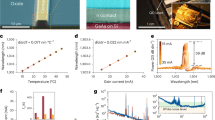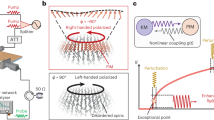Abstract
Integrated circulators and isolators are important for developing on-chip optical technologies such as laser cavities, communication systems and quantum information processors. These devices seem to inherently require mirror symmetry breaking to separate backwards from forwards propagation, and thus existing implementations rely on magnetic materials or interactions driven by propagating waves. By contrast to past works, we exhibit a mirror-symmetric non-reciprocal device that comprises three coupled photonic resonators implemented in thin-film lithium niobate. Applying radiofrequency modulation, we drive conversion between the frequency eigenmodes of this system. We measure nearly 40 dB of isolation for approximately 75 mW of radiofrequency power near 1,550 nm. We simultaneously generate non-reciprocal conversion between all of the eigenmodes to demonstrate circulation. Mirror-symmetric circulation simplifies the fabrication and operation of non-reciprocal integrated devices. Finally, we consider applications of such on-chip isolators and circulators, such as full-duplex isolation within a single waveguide.
This is a preview of subscription content, access via your institution
Access options
Access Nature and 54 other Nature Portfolio journals
Get Nature+, our best-value online-access subscription
$29.99 / 30 days
cancel any time
Subscribe to this journal
Receive 12 print issues and online access
$209.00 per year
only $17.42 per issue
Buy this article
- Purchase on Springer Link
- Instant access to full article PDF
Prices may be subject to local taxes which are calculated during checkout




Similar content being viewed by others
Data availability
The data comprising Fig. 4 and Supplementary Fig. 8 are available on Zenodo at https://doi.org/10.5281/zenodo.6537345. Additional data generated and analysed in this study are available from the corresponding author on reasonable request.
References
Wang, J., Herrmann, J. F., Witmer, J. D., Safavi-Naeini, A. H. & Fan, S. Photonic modal circulator using temporal refractive-index modulation with spatial inversion symmetry. Phys. Rev. Lett. 126, 193901 (2021).
Bi, L. et al. On-chip optical isolation in monolithically integrated non-reciprocal optical resonators. Nat. Photon. 5, 758–762 (2011).
Tzuang, L. D., Fang, K., Nussenzveig, P., Fan, S. & Lipson, M. Non-reciprocal phase shift induced by an effective magnetic flux for light. Nat. Photon. 8, 701–705 (2014).
Srinivasan, K. & Stadler, B. J. Magneto-optical materials and designs for integrated TE-and TM-mode planar waveguide isolators: a review. Opt. Mater. Express 8, 3307–3318 (2018).
Huang, D. et al. Electrically driven and thermally tunable integrated optical isolators for silicon photonics. IEEE J. Sel. Top. Quantum Electron. 22, 271–278 (2016).
Yan, W. et al. Waveguide-integrated high-performance magneto-optical isolators and circulators on silicon nitride platforms. Optica 7, 1555–1562 (2020).
Sobu, Y., Shoji, Y., Sakurai, K. & Mizumoto, T. GaInAsP/InP MZI waveguide optical isolator integrated with spot size converter. Opt. Express 21, 15373–15381 (2013).
Kittlaus, E. A., Otterstrom, N. T., Kharel, P., Gertler, S. & Rakich, P. T. Non-reciprocal interband Brillouin modulation. Nat. Photon. 12, 613–619 (2018).
Kittlaus, E. A. et al. Electrically driven acousto-optics and broadband non-reciprocity in silicon photonics. Nat. Photon. 15, 43–52 (2021).
Kim, S., Sohn, D. B., Peterson, C. W. & Bahl, G. On-chip optical non-reciprocity through a synthetic hall effect for photons. APL Photon. 6, 011301 (2021).
Shen, Z. et al. Experimental realization of optomechanically induced non-reciprocity. Nat. Photon. 10, 657–661 (2016).
Ruesink, F., Miri, M.-A., Alu, A. & Verhagen, E. Nonreciprocity and magnetic-free isolation based on optomechanical interactions. Nat. Commun. 7, 1–8 (2016).
Kang, M. S., Butsch, A. & Russell, P. S. J. Reconfigurable light-driven opto-acoustic isolators in photonic crystal fibre. Nat. Photon. 5, 549–553 (2011).
Kim, J., Kuzyk, M. C., Han, K., Wang, H. & Bahl, G. Non-reciprocal Brillouin scattering induced transparency. Nat. Phys. 11, 275–280 (2015).
Dong, C.-H. et al. Brillouin-scattering-induced transparency and non-reciprocal light storage. Nat. Commun. 6, 1–6 (2015).
Hafezi, M. & Rabl, P. Optomechanically induced non-reciprocity in microring resonators. Opt. Express 20, 7672–7684 (2012).
Tian, H. et al. Magnetic-free silicon nitride integrated optical isolator. Nat. Photon. 15, 828–836 (2021).
Sohn, D. B., Örsel, O. E. & Bahl, G. Electrically driven optical isolation through phonon-mediated photonic Autler–Townes splitting. Nat. Photon. 15, 822–827 (2021).
Fang, K., Yu, Z. & Fan, S. Photonic Aharonov–Bohm effect based on dynamic modulation. Phys. Rev. Lett. 108, 153901 (2012).
Lira, H., Yu, Z., Fan, S. & Lipson, M. Electrically driven nonreciprocity induced by interband photonic transition on a silicon chip. Phys. Rev. Lett. 109, 033901 (2012).
Doerr, C. R., Dupuis, N. & Zhang, L. Optical isolator using two tandem phase modulators. Opt. Lett. 36, 4293–4295 (2011).
Yu, Z. & Fan, S. Complete optical isolation created by indirect interband photonic transitions. Nat. Photon. 3, 91–94 (2009).
Dostart, N., Gevorgyan, H., Onural, D. & Popović, M. A. Optical isolation using microring modulators. Opt. Lett. 46, 460–463 (2021).
Weis, R. S. & Gaylord, T. K. Lithium niobate: summary of physical properties and crystal structure. Appl. Phys. A 37, 191–203 (1985).
McKenna, T. P. et al. Cryogenic microwave-to-optical conversion using a triply resonant lithium-niobate-on-sapphire transducer. Optica 7, 1737–1745 (2020).
Jiang, H. et al. Fast response of photorefraction in lithium niobate microresonators. Opt. Lett. 42, 3267–3270 (2017).
Xu, Y. et al. Mitigating photorefractive effect in thin-film lithium niobate microring resonators. Opt. Express 29, 5497–5504 (2021).
Shams-Ansari, A. et al. Probing the limits of optical loss in ion-sliced thin-film lithium niobate. In Conference on Lasers and Electro-Optics STh4J.4 (Optical Society of America, 2021); http://www.osapublishing.org/abstract.cfm?URI=CLEO_SI-2021-STh4J.4
Jiang, W. et al. Efficient bidirectional piezo-optomechanical transduction between microwave and optical frequency. Nat. Commun. 11, 1166 (2020).
Shao, L. et al. Microwave-to-optical conversion using lithium niobate thin-film acoustic resonators. Optica 6, 1498–1505 (2019).
Sarabalis, C. J., McKenna, T. P., Patel, R. N., Van Laer, R. & Safavi-Naeini, A. H. Acousto-optic modulation in lithium niobate on sapphire. APL Photon. 5, 086104 (2020).
Acknowledgements
J.F.H. acknowledges support from the National Science Foundation Graduate Research Fellowship Program (grant no. DGE-1656518). V.A. acknowledges support by the Stanford Q-FARM Bloch Fellowship Program. We acknowledge the support of an AFOSR MURI project (grant no. FA9550-18-1-0379) and the National Science Foundation under award no. ECCS-1820938. Part of this work was performed at the Stanford Nano Shared Facilities (SNSF), supported by the National Science Foundation under award no. ECCS-2026822. Work was performed in part at the nano@stanford laboratories, which are supported by the National Science Foundation as part of the National Nanotechnology Coordinated Infrastructure under award no. ECCS-1542152. We would like to thank W. Jiang and C. J. Sarabalis for insightful and helpful discussions.
Author information
Authors and Affiliations
Contributions
J.F.H. fabricated the device. J.F.H. and V.A. led the experimental effort. J.W. developed the device operating theory and characterized theoretical device performance. J.F.H, J.D.W. and J.W. determined physical device designs. J.D.W. assisted in early experimentation. A.H.S.-N and S.F. provided experimental and theoretical guidance and support for this experiment.
Corresponding authors
Ethics declarations
Competing interests
The authors declare no competing interests.
Peer review
Peer review information
Nature Photonics thanks the anonymous reviewers for their contribution to the peer review of this work.
Additional information
Publisher’s note Springer Nature remains neutral with regard to jurisdictional claims in published maps and institutional affiliations.
Supplementary information
Supplementary information
Supplementary Analysis and Discussion, Sections 1–8, Figs. 1–8 and Tables 1–3.
Rights and permissions
About this article
Cite this article
Herrmann, J.F., Ansari, V., Wang, J. et al. Mirror symmetric on-chip frequency circulation of light. Nat. Photon. 16, 603–608 (2022). https://doi.org/10.1038/s41566-022-01026-7
Received:
Accepted:
Published:
Issue Date:
DOI: https://doi.org/10.1038/s41566-022-01026-7
This article is cited by
-
Integrated electro-optic isolator on thin-film lithium niobate
Nature Photonics (2023)
-
Direct extraction of topological Zak phase with the synthetic dimension
Light: Science & Applications (2023)
-
Integrated passive nonlinear optical isolators
Nature Photonics (2023)
-
Resonators with tailored optical path by cascaded-mode conversions
Nature Communications (2023)



